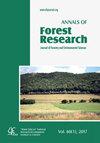光谱质量对山茱萸和桉树扦插生根的影响
IF 1.7
3区 农林科学
Q2 FORESTRY
引用次数: 0
摘要
为了更好地适应基于微小扦插技术的无性系植物幼苗生产过程,在经济作物组成中扩大了杉属和桉树属的物种和杂交组合的使用。本研究旨在评价光谱质量对andrewsii、saligna、microcorys、cloeziana、leulularis、ergrandis、ergrandis × erurophylia和Corymbia torelliana幼苗生根的影响,以帮助更好地了解无性系植物的生产。大肠茅×e . urophylla和c torelliana根解剖结构进行了分析。利用荧光、红、蓝三种光谱源,评价了光谱质量对小扦插生根的影响。成活率(SUR)、胼胝质形成率(CAL)、氧化率(OXI)和生根率(RO);最大根的长度(RL)和直径(ROD);30 d时,测定每分钟平均根数(NRM)、根表皮厚度(RET)、根皮质直径(RCD)、根维管柱直径(DRVC)和根直径(RD)。结果表明,波长特异性是优化桉树无性系大规模生产的有效技术。荧光光谱质量对盐碱根(68.7%)、细茎根(43.7%)、毛蕊根(75.0%)和细茎根(75.0%)最适宜;蓝色光谱质量最适宜的品种为andrewsii(55.5%)、grandis(75.0%)和grandis × urophylla (81.3%);红光谱质量最适宜的为cloeziana(56.2%)。本文章由计算机程序翻译,如有差异,请以英文原文为准。
Influence of spectral quality on the rooting of Corymbia and Eucalyptus spp. minicuttings
The pursuit of better adaptation in clonal plants seedling production processes based on the minicutting technique has expanded the use of species and hybrid combinations of genera Corymbia and Eucalyptus in the composition of commercial crops. The aim of the work was to evaluate the effect of spectral quality on the rooting of Eucalyptus andrewsii, E. saligna, E. microcorys, E. cloeziana, E. pilularis, E. grandis, E. grandis × E. urophylla and Corymbia torelliana minicuttings to help better understanding the production of clonal plants. E. grandis × E. urophylla and C. torelliana root anatomy was analyzed. The effects of spectral quality on the rooting of minicuttings were evaluated based on three sources (fluorescent, red and blue). Survival (SUR), callogenesis (CAL), oxidation (OXI) and rooting (RO) percentage; length (RL) and diameter of the largest root (ROD); mean number of roots per minicutting (NRM), root epidermis thickness (RET), root cortex diameter (RCD), diameter of the root vascular cylinder (DRVC) and root diameter (RD) were evaluated at 30 days. Based on the results, wavelength specificity was a useful technology to optimize the large-scale production of clonal plants of Eucalyptus. Fluorescent spectral quality was the most appropriate source in the rooting of E. saligna (68.7%), E. microcorys (43.7%), E. pilularis (75.0%) and C. torelliana (75.0%) minicuttings; blue spectral quality was the most appropriate for E. andrewsii (55.5%), E. grandis (75.0%) and E. grandis × E. urophylla (81.3%); and red spectral quality was the most appropriate for E. cloeziana (56.2%).
求助全文
通过发布文献求助,成功后即可免费获取论文全文。
去求助
来源期刊

Annals of Forest Research
FORESTRY-
CiteScore
2.20
自引率
11.10%
发文量
11
审稿时长
12 weeks
期刊介绍:
Annals of Forest Research is a semestrial open access journal, which publishes research articles, research notes and critical review papers, exclusively in English, on topics dealing with forestry and environmental sciences. The journal promotes high scientific level articles, by following international editorial conventions and by applying a peer-review selection process.
 求助内容:
求助内容: 应助结果提醒方式:
应助结果提醒方式:


